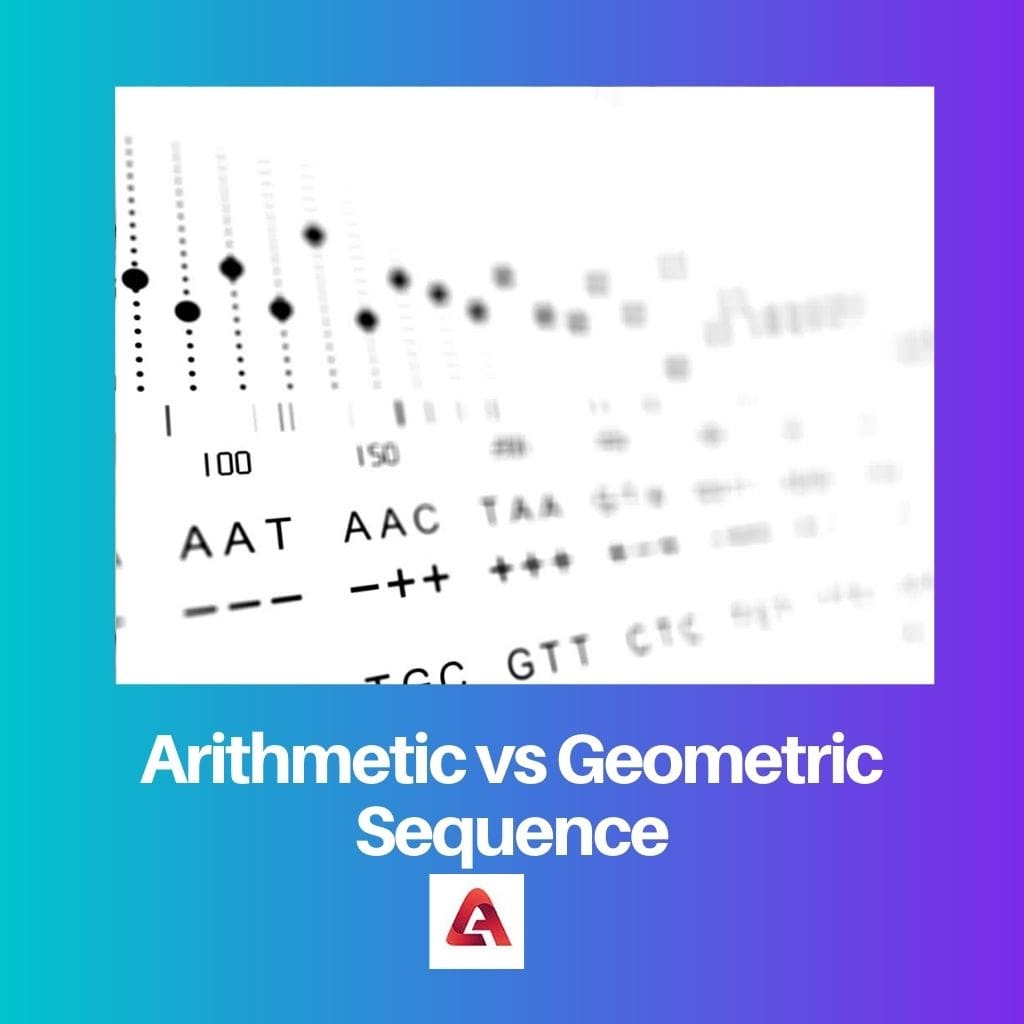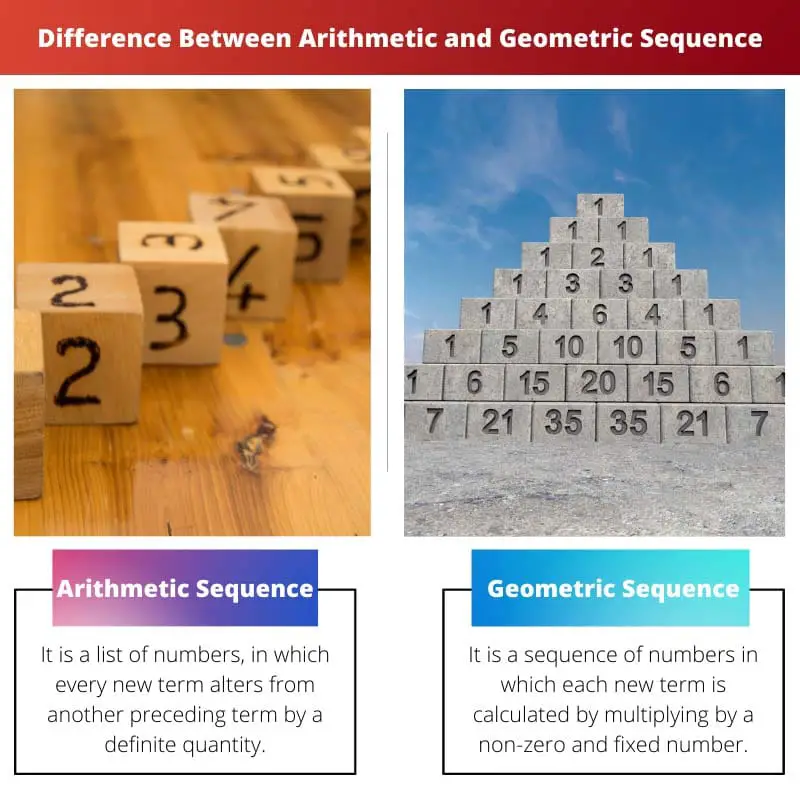Arithmetic sequences involve a constant difference between consecutive terms, while geometric sequences involve a constant ratio between consecutive terms.
Key Takeaways
- Arithmetic sequence is a sequence where each term is obtained by adding a constant to the preceding term.
- Geometric sequence is a sequence where each term is obtained by multiplying a constant by the preceding term.
- Arithmetic sequence is used to model linear relationships, while the geometric sequence is used to model exponential relationships.
Arithmetic vs Geometric Sequence
The variation between the members of an arithmetic sequence is linear, while the variation in the geometric sequence’s elements is exponential. Infinite arithmetic sequence diverges; on the other hand, infinite geometric sequences converge or diverge, depending on the situation.

The difference between two consecutive terms in an arithmetic sequence is common. On the other hand, the ratio of two consecutive terms in a geometric sequence is referred to as the standard ratio.
Comparison Table
| Feature | Arithmetic Sequence | Geometric Sequence |
|---|---|---|
| Definition | A sequence where each term is obtained by adding a constant value (common difference) to the previous term. | A sequence where each term is obtained by multiplying the previous term by a constant value (common ratio). |
| Formula | a_n = a_1 + d(n-1) | a_n = a_1 * r^(n-1) |
| Key Characteristic | Constant difference between terms. | Constant ratio between terms. |
| Behavior | Terms increase or decrease by a constant value. | Terms increase or decrease exponentially. |
| Sum of the first n terms | S_n = n/2 * (a_1 + a_n) | S_n = a_1 * (1-r^n) / (1-r) |
| Examples | 2, 5, 8, 11, 14, … | 2, 6, 18, 54, 162, … |
| Applications | Financial calculations, population growth, physics (falling objects), music theory | Compound interest, exponential decay, population growth, geometric shapes |
What is Arithmetic Sequence?
An arithmetic sequence is a sequence of numbers where each term is obtained by adding a constant value (called the common difference) to the previous term. It’s a specific sequence type with predictable behavior and applications in various fields.
Here’s a breakdown of its key characteristics:
Definition:
- An ordered list of numbers where each term is obtained by adding the same number (common difference) to the previous term.
Formula:
- a_n = a_1 + d(n-1)
- a_n: nth term of the sequence.
- a_1: first term of the sequence.
- d: common difference.
- n: position of the term in the sequence.
Key Characteristic:
- Constant common difference: Each term differs from the previous term by the same constant value, determining the sequence’s progression.
Behavior:
- Linear progression: The terms increase or decrease by a constant value (d).
- Predictable pattern: Due to the constant difference, the sequence’s terms are easily predictable and can be calculated using the formula.
Sum of the first n terms:
- S_n = n/2 * (a_1 + a_n)
- S_n: sum of the first n terms.
- n: number of terms.
- a_1: first term.
- a_n: nth term.
Examples:
- 2, 5, 8, 11, 14, … (common difference of 3)
- -10, -7, -4, -1, 2, … (common difference of 3)
- 3, 7, 11, 15, 19, … (common difference of 4)
Applications:
- Finance: Calculating compound interest, loan payments, and future values.
- Physics: Analyzing falling objects, projectile motion, and simple harmonic motion.
- Music theory: Understanding intervals and scales.
- Population growth: Modelling linear population growth over time.

What is a Geometric Sequence?
A geometric sequence is a sequence of numbers where each term is obtained by multiplying the previous term by a constant value (called the common ratio). It’s a specific sequence type with distinctive characteristics and applications in numerous fields.
Here’s a breakdown of its key features:
Definition:
- An ordered list of numbers where the relationship between terms is based on constant multiplication.
- Each term is obtained by multiplying the previous term by a fixed number (common ratio).
Formula:
- a_n = a_1 * r^(n-1)
- a_n: nth term of the sequence.
- a_1: first term of the sequence.
- r: common ratio.
- n: position of the term in the sequence.
Key Characteristic:
- Constant common ratio: The sequence progresses by multiplying each term by the same constant value (r), determining its growth or decay.
Behavior:
- Exponential growth or decay: Depending on the value of the common ratio, the terms of the sequence can increase or decrease exponentially.
- Rapid change: Compared to arithmetic sequences, geometric sequences experience faster rate of change as the sequence progresses.
Convergence or divergence:
- A geometric sequence converges if the absolute value of the common ratio is less than 1.
- It diverges if the absolute value of the common ratio is greater than or equal to 1.
Sum of the first n terms:
- S_n = a_1 * (1-r^n) / (1-r)
- S_n: sum of the first n terms.
- n: number of terms.
- a_1: first term.
- r: common ratio.
Examples:
- 2, 6, 18, 54, 162, … (common ratio of 3)
- 1/2, 1/4, 1/8, 1/16, 1/32, … (common ratio of 1/2)
- -3, 9, -27, 81, -243, … (common ratio of -3)
Applications:
- Finance: Calculating compound interest, exponential growth models, and depreciation.
- Science: Modelling radioactive decay, population growth with limited resources, and geometric shapes.
- Music theory: Understanding intervals and logarithms related to pitch.
- Cryptography: Implementing encryption algorithms based on modular arithmetic.

Main Differences Between Arithmetic and Geometric Sequence
- Pattern of Progression:
- Arithmetic Sequence: Each term in an arithmetic sequence is obtained by adding a fixed constant (called the “common difference”) to the preceding term, resulting in a linear progression.
- Geometric Sequence: Each term in a geometric sequence is obtained by multiplying the preceding term by a fixed constant (called the “common ratio”), resulting in an exponential progression.
- Formula:
- Arithmetic Sequence: The general formula for an arithmetic sequence is an = a1 + (n – 1) * d, where an represents the nth term, a1 is the first term, and d is the common difference.
- Geometric Sequence: The general formula for a geometric sequence is an = a1 * r^(n – 1), where an represents the nth term, a1 is the first term, and r is the common ratio.
- Rate of Change:
- Arithmetic Sequence: The rate of change between consecutive terms is constant and equal to the common difference (d).
- Geometric Sequence: The rate of change between consecutive terms is constant and equal to the common ratio (r).
- Example Progression:
- Arithmetic Sequence: An example of an arithmetic sequence is 2, 4, 6, 8, 10, …, where the common difference (d) is 2.
- Geometric Sequence: An example of a geometric sequence is 3, 6, 12, 24, 48, …, where the common ratio (r) is 2.
- Nature of Terms:
- Arithmetic Sequence: Terms in an arithmetic sequence represent quantities that increase or decrease by a fixed amount with each term.
- Geometric Sequence: Terms in a geometric sequence represent quantities that grow or diminish by a fixed proportion with each term.
- Sum of Terms:
- Arithmetic Sequence: The sum of the first n terms of an arithmetic sequence can be calculated using the formula Sn = (n/2) * [2 * a1 + (n – 1) * d], where Sn is the sum, n is the number of terms, a1 is the first term, and d is the common difference.
- Geometric Sequence: The sum of the first n terms of a geometric sequence can be calculated using the formula Sn = (a1 * (1 – r^n)) / (1 – r), where Sn is the sum, n is the number of terms, a1 is the first term and r is the common ratio.


The comparison table listing the differences between arithmetic and geometric sequences is very informative and makes it easy to understand the distinctions between these two types of sequences.
Absolutely, it’s a great reference for students and anyone looking to understand the fundamental differences between arithmetic and geometric sequences.
Agreed. The table clearly outlines the key features of each sequence, making it easy to grasp the concepts.
The clear distinction between the behaviors and applications of arithmetic and geometric sequences provides valuable insights into their roles and significance in diverse fields.
I couldn’t agree more. The post effectively encapsulates the essence of both sequence types and their real-world implications.
The post effectively highlights the essential differences between arithmetic and geometric sequences, providing a clear understanding of their unique characteristics and behaviors.
Absolutely. The post aptly demonstrates the contrasting linear and exponential progressions of these two sequences.
While the explanation of arithmetic sequences was quite clear, the detailed breakdown of geometric sequences provided a deeper insight into their behavior and applications.
I found the section on geometric sequences particularly enlightening. It shed light on their role in exponential growth and decay, as well as their real-world applications.
Agreed. The examples of geometric sequences helped to showcase the rapid change and exponential behavior of these sequences.
The comprehensive explanation of the key characteristics and behaviors of arithmetic and geometric sequences is highly enlightening and serves as an excellent foundation for understanding these sequence types.
Indeed. It’s impressive how the post effectively captures the nuances of both sequence types and their practical applications.
The applications section sheds light on the practical relevance of arithmetic and geometric sequences, further enhancing the understanding of their significance in different domains.
Absolutely. The examples clearly highlight the wide-ranging applications of these sequences, ranging from financial calculations to population growth modeling.
Certainly. The real-world applications provide valuable context for grasping the importance of these sequences in varied fields.
The comprehensive explanations and illustrative examples provide a thorough understanding of the behaviors and applications of arithmetic and geometric sequences, making it a valuable resource for learners and educators alike.
Absolutely. The applications of these sequences in different fields are well presented and contribute to the overall clarity of the post.
Agreed. The post is highly informative and serves as an excellent reference for studying the properties of these sequences.
The in-depth explanations of the behaviors and applications of arithmetic and geometric sequences provide a comprehensive understanding of their significance in various fields.
Definitely. It’s fascinating to see how these sequences are applied in finance, physics, music theory, and more.
Absolutely. The real-world examples help to illustrate the practical implications of these sequences.
This post provides an excellent overview of arithmetic and geometric sequences and does a great job of explaining the key characteristics and applications of these sequences.
I agree! The breakdown of the formulas for both sequences is particularly helpful for understanding their definitions and behaviors.
The breakdown of the key characteristics of arithmetic and geometric sequences is both clear and concise, making it an excellent educational resource for students of mathematics and related fields.
Indeed. The post effectively outlines the fundamental elements of these sequences in a well-structured manner.